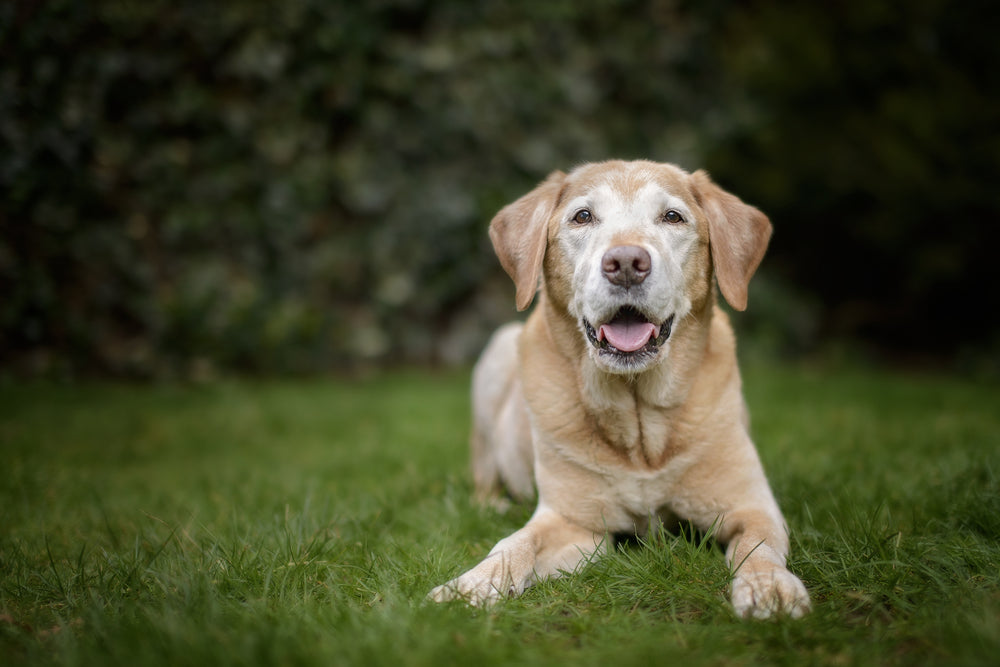Arthritis is much more common in dogs than you would believe: 4 out of 5 older dogs will suffer from it. Whilst it’s very unlikely to be your fault if your dog develops arthritis, you can take some very positive steps now that will help your dog cope with it.
Be positive
We don’t want to be downbeat about this, but let’s be honest, arthritis is something that happens to many of us dog owners, let alone dogs. We suffer together. What may seem a bit of ‘old age’ or ‘aches and pains’, is often the onset of arthritis. All too often these labels become excuses which prevent the treatment that will help. This is a pity. Just because arthritis cannot be cured does not mean it should be tolerated. There are many steps that can be taken to make life better with arthritis.
Vicious circle
In dogs and humans, it can be genetic, a result of trauma or simply be caused by wear and tear. Cartilage between joints just wears out over time, leaving bone rubbing on bone. This is when the vicious cycle begins, because the more it hurts, the less a dog wants to do. Muscles and tendons weaken and mobility is reduced. Then weight is gained and pain increases, and so it goes on.
Obesity danger
Obesity is getting worse in dogs and overweight dogs are more likely to be arthritic dogs. If a dog is arthritic and overweight, the pain could be more severe. See the brilliant advice about weight control on The Canine Arthritis Management, (CAM), Charity website here. One of their clever suggestions is to find a vet which has a weight clinic with regular weigh-ins. This 'Weight Watchers' approach provides the motivation needed for lifestyle changes which are hard to make.
Breeds more prone
In breeds more likely to suffer from hip dysplasia or arthritis, (Newfoundland, Saint Bernard, Old English Sheepdog, Rottweiler, German Shepherd, Golden Retriever, Alaskan Malamute, Labrador Retriever, and Samoyed), it is worth taking preventive measures right from the start. Primarily these are: the avoidance of weight gain, slippy floors, excessive exercise, tough terrain and cold. If you buy one of these breeds, it's worth getting good insurance cover for arthritis. At Ruff and Tumble we use Lifetime Pet Cover because they include arthritis cover, (as long as it's not pre-existing). They also include up to £1,000 per year of complementary therapy cover. A subtle but important detail of this policy is that it is literally for life, which is so important in ongoing and chronic conditions. It's not stopped or capped after a claim.
Signs to look for
Getting early diagnosis and treatment is very important because you are then managing it from the beginning, and in control. Be vigilant about your dog’s behaviour, posture and capability. A reluctance to go on walks, licking of paws or lameness, and pacing at night, can all be signs of arthritis. See other symptoms here. The truth is, these symptoms are insidious and creep in over time. If you have observed even subtle changes, it’s time to visit the vet for an assessment.
Treatment
The range of treatment for arthritis is slightly mind-boggling. CAMS have a treatment pyramid here which is very clear and guides you through the pros and cons of all options. Some advice seems almost obvious – like avoiding sand, stone and hills on walks, for example. But we are all busy creatures of habit, and changing routines is often not as simple as it sounds. You’ll find sensible advice on trying complementary therapies, as well as the side effects of stronger anti-inflammatory medicines, which are known as NSAIDS. Turmeric paste for dogs and Cannabis Oil may work for some, whilst others will swear by hydrotherapy and NSAIDS. There is a very helpful forum as well as case studies, if you want reassurance or ideas.
Our work with CAM
We wanted to write about arthritis because it affects so many dogs and there is no cure. CAM work incredibly hard to educate us about all the inspiring results that can happen from managing arthritis effectively and positively. We know how much our customers’ dogs love hydrotherapy, and how useful they find our drying coats afterwards for keeping dogs warm. Do tell us how you are managing your dog’s arthritis, we’d love to hear about it.
We’ll be working with CAM over the next year to raise awareness and understanding of this disease, so watch this space!


